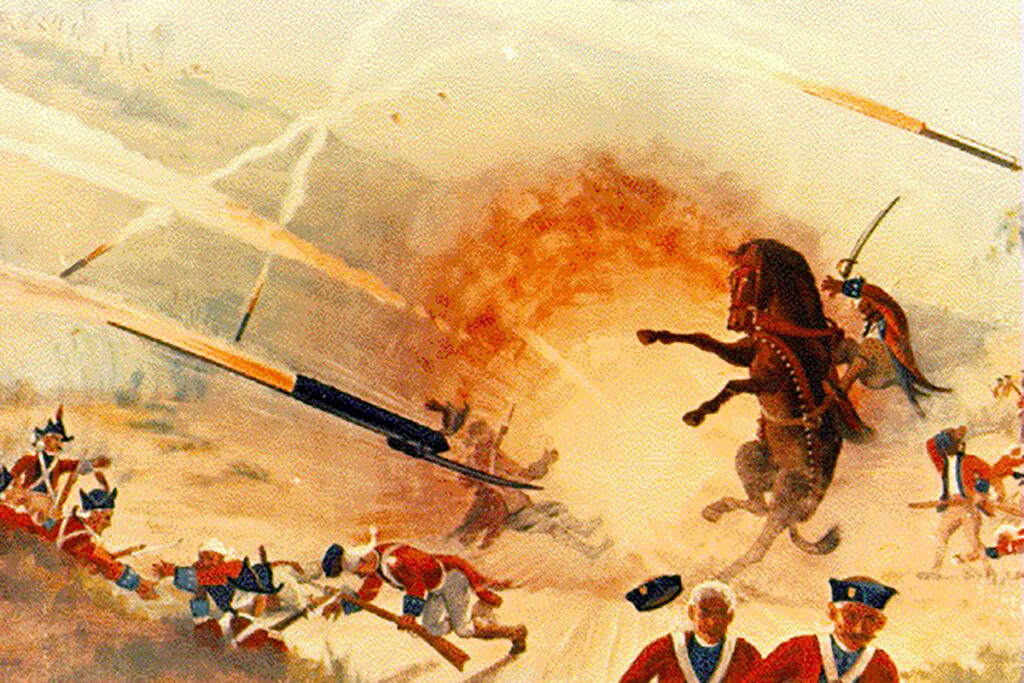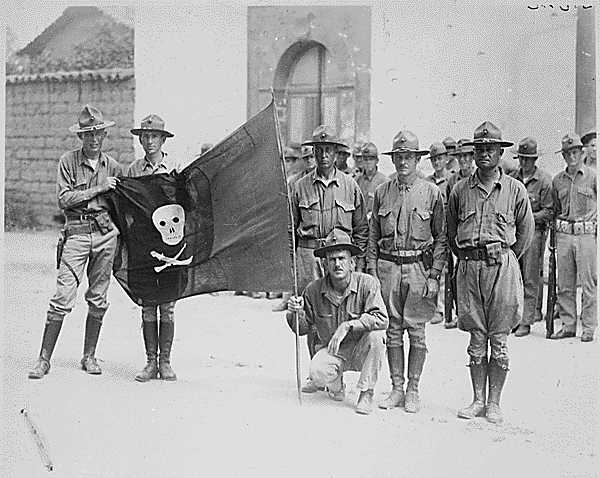This article by Matt Fratus was originally published by Coffee or Die.
Centuries before the United States military was launching GPS-guided missiles from battleships, warplanes, and helicopter gunships, armies waged war with surprisingly capable technologies of their own. The first documented use of rockets in a military capacity was in 1232 during the battle of Kai-Keng between China and the Mongols. The Chinese repelled Mongolian invaders with a barrage of “arrows of flying fire.” The fire arrows were tubes of gunpowder capped at one end and mounted on long sticks that helped keep the rockets’ flight paths steady.
Tipu Sultan, the king of the state of Mysore in India, is famous for the next big development in rocket technology: Mysorean rockets. It was actually Tipu Sultan’s father, Hyder Ali, who first developed and deployed the rockets in the late 1700s. They were cased in iron, and Tipu Sultan used them against the British army.
“The rockets and musketry from 20,000 of the enemy were incessant,” a British officer wrote at the time. “No hail could be thicker. Every illumination of blue lights was accompanied by a shower of rockets, some of which entered the head of the column, passing through to the rear, causing death, wounds, and dreadful lacerations from the long bamboos of twenty or thirty feet, which are invariably attached to them.”
The British stole the technology and dubbed it the Congreve Rocket. Congreve rockets became famous when British ships used them in an attack on Fort Henry in the War of 1812, which served as the inspiration for Francis Scott Key’s line regarding “the rockets’ red glare” in his poem that became “The Star-Spangled Banner.”

In World War II, Nazi scientists raced to develop the V-2 rocket, a precursor to postwar-era intercontinental ballistic missiles (ICBMs). These 46-foot, liquid-fueled, long-range rockets could deliver 2,200-pound warheads 200 miles on trajectories that reached altitudes of 55 miles. These V-2 rockets also had mobile launchpads, which allowed operators to set up stations without being detected and strike targets unexpectedly. Although the rockets were only in use toward the end of the war, the Nazis still managed to launch 3,000 of the V-2s, killing an estimated 7,250 Allied personnel and civilians.
The Nazis were defeated, and their empire lay in ruins, yet their missile program advanced with the help of the top-secret intelligence program called Operation Paperclip. The program, operating under the US government’s umbrella, recruited former Nazi scientists to work for NASA and give the US superiority in the space and arms races against the Soviet Union during the Cold War.
Related: The Soviets crashed into the moon while Apollo 11 was on it
In the late 1950s, the US government put roughly $8 billion and 33,000 workers toward perfecting a brand-new ICBM program, Project Atlas. “The Air Force’s Ballistic Missile Program represents a concerted effort of unprecedented magnitude jointly pursued by the most competent and widespread government, science, and industry teams ever assembled on a single project,” recalled Gen. Bernard A. Schriever, a veteran of World War II B-17 combat missions. Russia’s success in sending Sputnik — the world’s first satellite — to space in 1957 was enough to drive the US military to invest heavily in the project.

In Vietnam, rocketry took off with the emergence of varied aerial platforms, including aircraft, helicopters, and gunships. The Hughes AIM-4 Falcon was the first air-to-air missile the US Air Force adopted. It was conceived as a self-defense weapon for B-52 bombers. However, legendary ace fighter pilot Col. Robin Olds, an outspoken critic of the missiles, wrote about his displeasure in his book Fighter Pilot: The Memoirs of Legendary Ace Robin Olds.
“In the thick of an engagement with my head twisting and turning, trying to keep track of friend and foe, I’d forget which of the four I had (already) selected and couldn’t tell which of the remaining was perking and which head was already expiring on its launch rail,” Olds wrote. “Twice upon returning to base I had the tech rep go over the switchology and firing sequences. We never discovered I was doing anything wrong.”
While fast movers didn’t appreciate the unreliable missiles, AH-1 Cobra “Snake” and Hughes OH-6A “Loach” helicopters made names for themselves using 2.75-inch air-to-ground rockets divided between two rocket launchers mounted on each side of the craft.
Lt. Col. Ace Cozzalio, a colorful character who wore an 1860s American Civil War cavalry uniform, flew Snakes and Loaches in Vietnam. These helicopter gunships flew together on search-and-destroy missions. The Loaches used their agility to scout and recon targets, and if caught in a dicey scenario, they had miniguns that’d decimate a platoon-sized element of Viet Cong with ease. It was the Cobras that engaged enemy combatants hidden in fortified bunkers with rockets. Following his actions on Jan. 25, 1969, the US Army Air Cavalry officer was only referred to as that “crazy helicopter pilot.”

A seven-man long-range reconnaissance patrol (LRRP) from the 9th Infantry Division was ambushed by the North Vietnamese Army in an area north of Phu My and called for immediate close-air support. Cozzalio and another Cobra gunship from D Troop, 3-5 Air Cavalry, took flight. Upon entry into the battle space, he located the LRRP team, snaked his aircraft to hover 30 feet above them, and raked the tree line with rockets, miniguns, and 40 mm grenades. It was because of Cozzalio that the LRRP team made it out that day. In his three tours of duty, he was awarded 49 medals, and remarkably, because of his fast-and-low flying style, he was shot down six times and suffered injuries in three additional hard landings.
With the Vietnam War coming to an end, the AH-64 Apache made its first flight in 1975. The Apache helicopter is considered the US Army’s Swiss Army knife, and among its most capable weapons systems is the Hellfire missile. These air-to-ground missiles were developed to destroy tanks and other heavily armored vehicles. The first combat use of the Longbow Hellfire Modular Missile System was Dec. 20, 1989, during Operation Just Cause in Panama. AH-64 Apaches fired seven Hellfire missiles, and all were direct hits. The Apaches and their Hellfire missiles and Hydra-70 rockets destroyed two Iraqi early-warning ground control radar sites as the first shots fired in Operation Desert Storm on Jan. 17, 1991.
Related: What’s the difference between a cruise missile and a ballistic missile?
During this period, the Tomahawk cruise missile also made its debut in warfare. The Tomahawk cruise missile program, which had been canceled in the 1940s, was revived in the 1970s. In 1983, defense contractor McDonnell Douglas introduced the new missile. The Tomahawk premiered when it was fired from the USS Paul F. Foster in the Persian Gulf War. The US Navy launched nearly 300 additional missiles from ships and submarines in the subsequent days of the war. And it’s been here to stay ever since. As wars end and new conflicts begin, the technology of the past is forever relevant in the battles of the future.
Read more from Sandboxx News:
- Paul Douglas: The oldest recruit in the history of Parris Island
- The real military history on display in the ‘Star Wars’ saga
- 3 Black service members who helped shape history
- The 4 guns used to make the longest sniper kills in history
- 5 of the biggest things movies get wrong about grenades
Feature image: WikiMedia Commons




